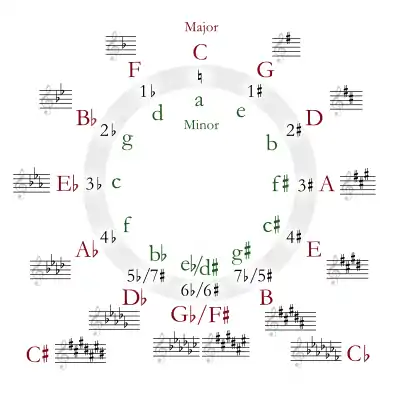B-flat minor
B-flat minor is a minor scale based on B♭, consisting of the pitches B♭, C, D♭, E♭, F, G♭, and A♭. Its key signature has five flats. Its relative major is D-flat major and its parallel major is B-flat major. Its enharmonic equivalent, A-sharp minor, which would contain seven sharps, is not normally used.
| Relative key | D-flat major |
|---|---|
| Parallel key | B-flat major |
| Dominant key | F minor |
| Subdominant | E-flat minor |
| Enharmonic | A-sharp minor |
| Component pitches | |
| B♭, C, D♭, E♭, F, G♭, A♭ | |
The B-flat natural minor scale is:
Changes needed for the melodic and harmonic versions of the scale are written in with accidentals as necessary. The B-flat harmonic minor and melodic minor scales are:
Scale Degree Chords
- Tonic - B-flat minor
- Supertonic - C diminished
- Mediant - D-flat major
- Subdominant - E-flat minor
- Dominant - F minor
- Submediant - G-flat major
- Subtonic - A-flat major
Characteristics
B-flat minor is traditionally a 'dark' key.[1]
The old valveless horn was barely capable of playing in B-flat minor: the only example found in 18th-century music is a modulation that occurs in the first minuet of Franz Krommer's Concertino in D major, Op. 80.[2]
Notable classical compositions
- Charles-Valentin Alkan
- Prelude Op. 31, No. 12 (Le temps qui n'est plus)
- Symphony for Solo Piano, 3rd movement: Menuet
- Samuel Barber
- Frédéric Chopin
- Franz Liszt
- Transcendental Étude No. 12 (Chasse-neige) from Transcendental Études
- Sergei Rachmaninoff
- Piano Sonata No. 2, Op. 36
- Alexander Scriabin
- Études Op. 8: No. 11 in B-flat minor
- Dmitri Shostakovich
- Symphony No. 13, Op. 113 ("Babi Yar")
- String Quartet No. 13, Op. 138
- Richard Strauss
- An Alpine Symphony begins and ends in B-flat minor.
- Pyotr Ilyich Tchaikovsky
- William Walton
References
- Wilfrid Mellers, "Round and About in Górecki's Symphony No. 3" Tempo 168 3 (1989): 23
- J. Murray Barbour, Trumpets, Horns, and Music (1964), p. 163
- Piano Sonata No. 2, Op. 35 (Chopin): Scores at the International Music Score Library Project
- Nocturnes, Op. 9 (Chopin): Scores at the International Music Score Library Project
- Scherzo No. 2, Op. 31 (Chopin): Scores at the International Music Score Library Project
- Preludes, Op.28 (Chopin): Scores at the International Music Score Library Project
- Piano Concerto No. 1, Op. 23 (Tchaikovsky): Scores at the International Music Score Library Project
External links
 Media related to B-flat minor at Wikimedia Commons
Media related to B-flat minor at Wikimedia Commons




